Appliances
What Are the Odds of a Ceiling Fan Falling?
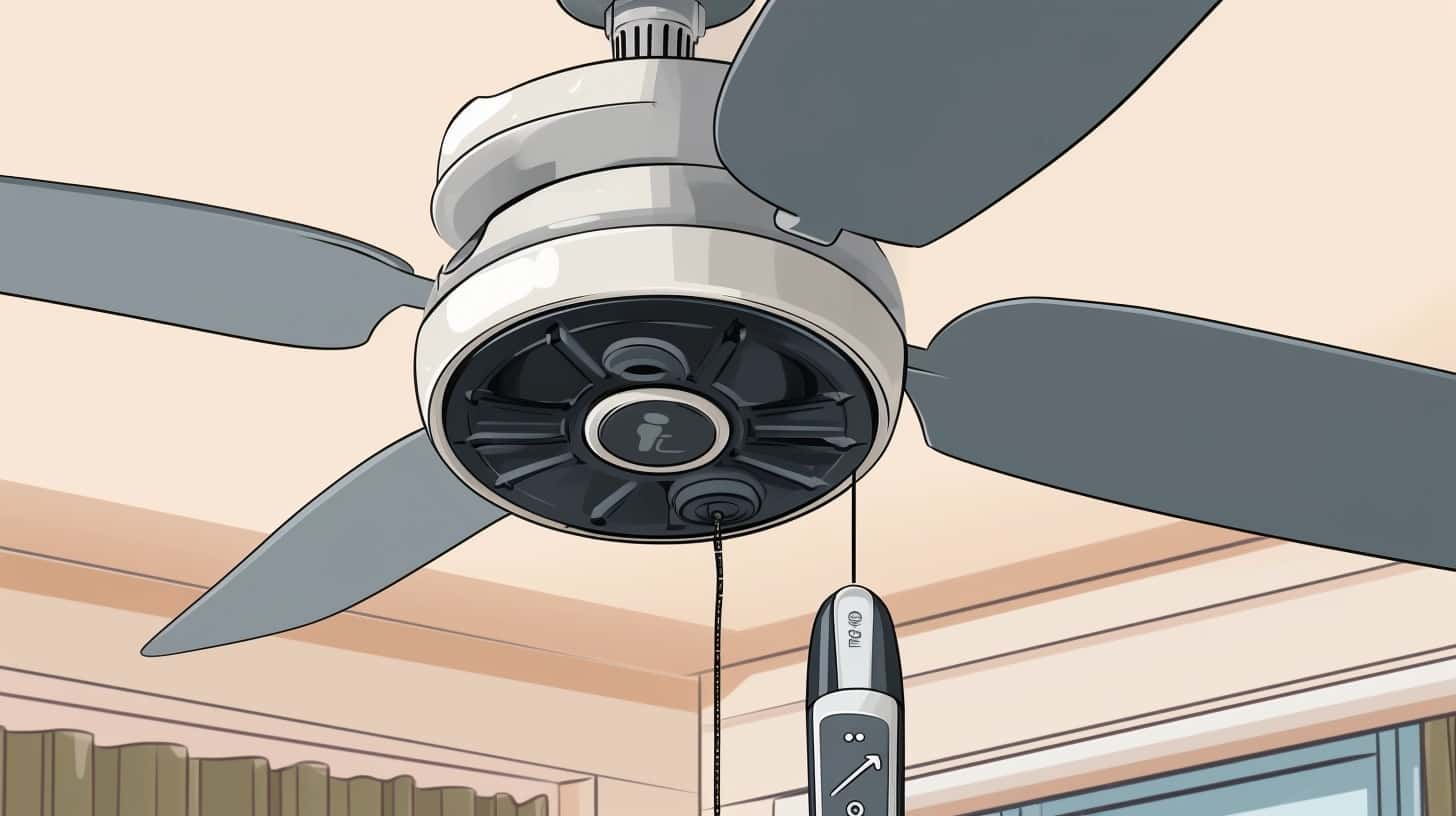
Gazing at the ceiling fan, which rotates leisurely overhead, prompts us to ponder the likelihood of it abruptly plummeting. Although it might appear to be a rare event, the security surrounding ceiling fans is a subject worthy of our consideration.
In this article, we will explore the factors that can contribute to a ceiling fan falling, such as improper installation and lack of maintenance. We will also delve into the physics behind these fixtures and examine the impact of their weight on safety.
Additionally, we will address common safety concerns in older homes and explore the safety standards and regulations that govern the manufacture and installation of ceiling fans.
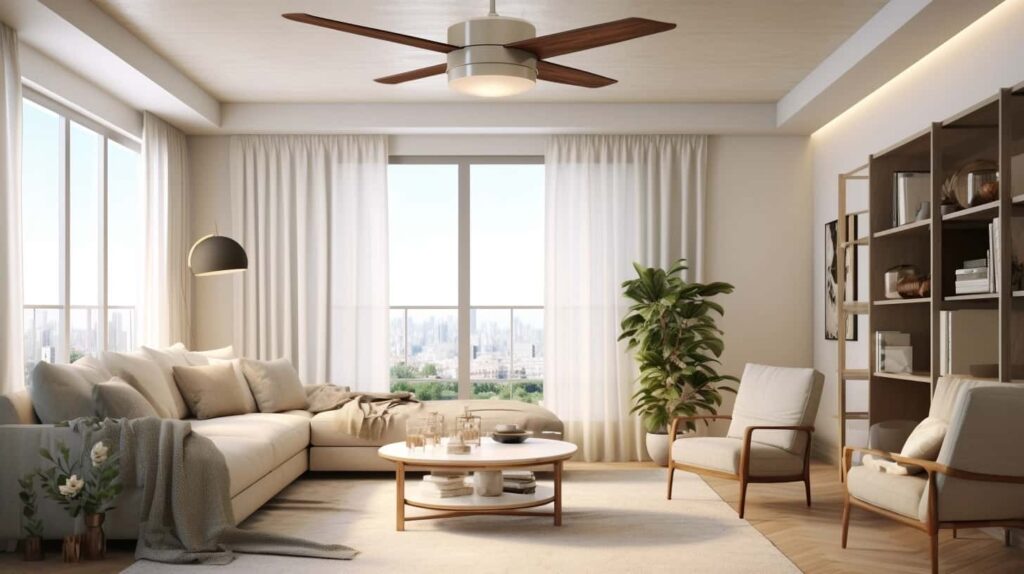
So, let’s dive in and uncover the truth about the odds of a ceiling fan falling.
Key Takeaways
- Proper installation techniques and regular maintenance are crucial for ceiling fan safety.
- Factors such as blade design, motor power, and mounting mechanisms contribute to fan stability.
- The structural load and integrity of the fan, including the ceiling’s capability to handle the weight and movement, are important considerations for stability.
- Neglecting regular maintenance, improper installation, and overloading the fan can increase the likelihood of instability and the ceiling fan falling.
Importance of Ceiling Fan Safety
Ceiling fan safety is of utmost importance in ensuring the well-being and protection of individuals within a space. Proper fan installation and regular maintenance are crucial to prevent accidents and maintain the optimal functioning of the fan.
When it comes to fan installation, it’s essential to follow the manufacturer’s instructions carefully. This includes ensuring that the fan is securely mounted to a suitable ceiling support structure, such as a joist or beam. It’s also important to check the electrical connections and wiring to ensure they’re properly installed and grounded.
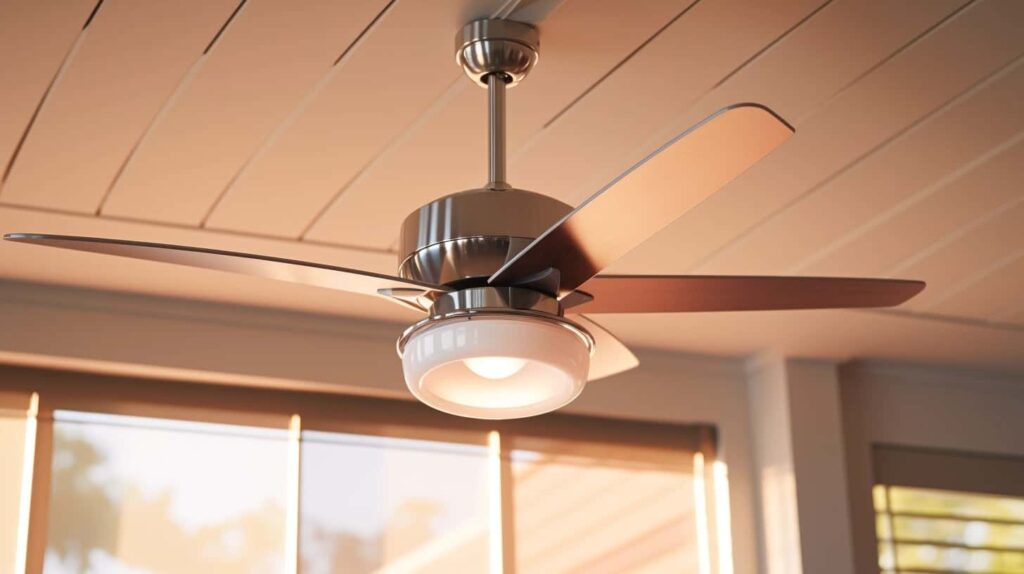
Regular maintenance is equally important in keeping the fan safe and efficient. Dust and debris can accumulate on the blades and motor over time, affecting the fan’s performance. Therefore, it’s recommended to clean the fan regularly using a soft cloth or brush. Additionally, checking for any loose screws or bolts and tightening them as necessary can help prevent the fan from wobbling or falling.
Understanding the Physics Behind Ceiling Fans
Understanding the physics behind ceiling fans is crucial for ensuring their safe and efficient operation. By considering fan stability factors such as blade design, motor power, and mounting mechanisms, we can create a balanced and stable fan that minimizes the risk of accidents.
Structural integrity considerations, such as the materials used and the fan’s weight distribution, also play a vital role in maintaining the fan’s stability and preventing potential hazards.
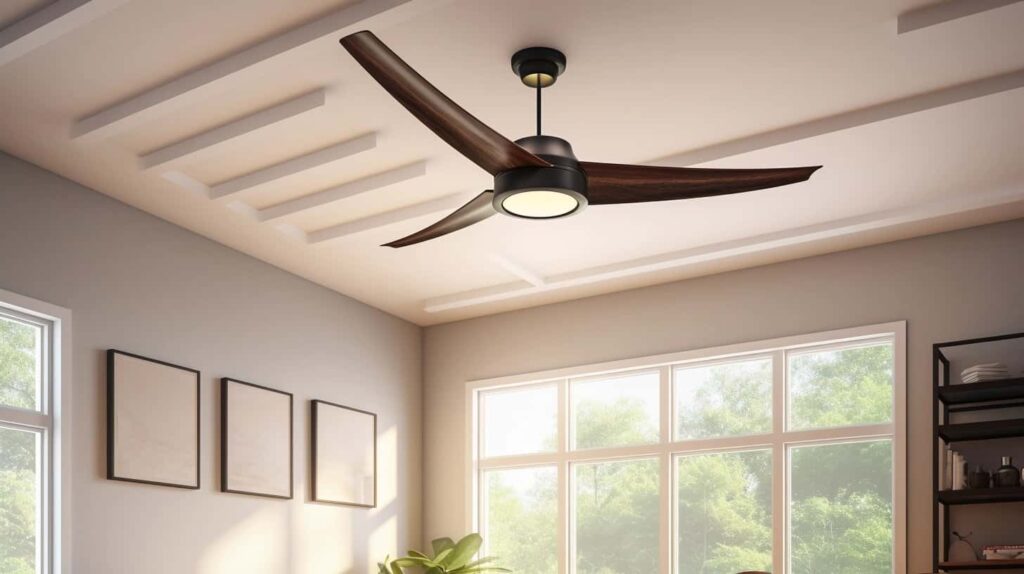
Fan Stability Factors
When considering the stability of ceiling fans, it’s crucial to understand the underlying physics that dictate their movement. Fan stability factors play a significant role in ensuring the safe operation of these fixtures.
Regular maintenance is of utmost importance to maintain the stability of ceiling fans. Here are three key factors that contribute to the stability of ceiling fans:
- Mounting: The fan must be securely mounted to a ceiling joist or other structural support to prevent any wobbling or shaking during operation.
- Balance: Proper balance is essential to prevent the fan from vibrating excessively. Regularly checking and adjusting the fan blades’ alignment and weight distribution can help maintain balance.
- Motor and Blade Quality: High-quality motors and blades are less likely to produce excessive vibrations or become loose over time, ensuring the stability of the fan.
Structural Integrity Considerations
Considering the intricate interplay between structural integrity and the physics of ceiling fans, it’s imperative to delve into the underlying mechanics that govern their operation.
When it comes to ceiling fan safety, two crucial aspects are the structural load and material durability.
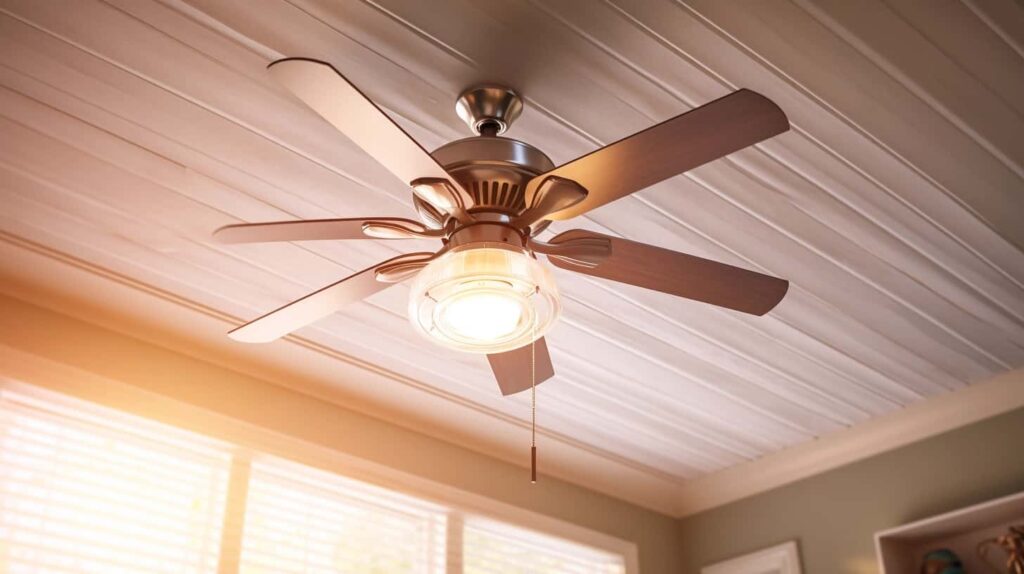
The structural load refers to the amount of weight and force that the ceiling fan exerts on the mounting system and the ceiling itself. It’s essential to ensure that the ceiling fan is properly installed, with adequate support from a secure and sturdy mounting bracket. Additionally, the ceiling must be capable of withstanding the weight and movement of the fan without any risk of failure.
Material durability is another vital consideration. The components of the ceiling fan, including the blades, motor, and mounting hardware, should be made of high-quality and durable materials. This ensures that the fan can withstand the stress and strain of continuous operation without any structural weaknesses or failures.
Factors That Can Contribute to a Ceiling Fan Falling
To prevent a ceiling fan from falling, it’s crucial to address the contributing factors that can lead to such incidents. Here are three key factors that can contribute to a ceiling fan falling:
- Poor fan maintenance: Neglecting regular fan maintenance can increase the risk of a ceiling fan falling. Over time, dust and debris can accumulate on the blades and motor, causing imbalances and strain on the fan’s structure. It’s essential to clean the fan regularly and keep it well-maintained to ensure its stability.
- Inadequate installation safety: Improper installation is a common factor contributing to ceiling fan accidents. If the fan isn’t securely mounted to the ceiling or if the mounting hardware isn’t suitable for the weight and size of the fan, it can loosen over time and lead to a potential fall. Following the manufacturer’s instructions and using appropriate mounting hardware is vital for a safe installation.
- Overloading the fan: Overloading the fan with heavy attachments or excessive weight can compromise its stability and increase the likelihood of it falling. Extra accessories, such as lights or decorative ornaments, should be installed according to the manufacturer’s specifications and weight limits. It’s important to ensure that the fan isn’t overloaded to maintain its structural integrity.
Examining the Quality of Ceiling Fan Installation
When examining the quality of ceiling fan installation, two key points come to mind: installation techniques and structural support.

Proper installation techniques ensure that the fan is securely attached to the ceiling, minimizing the risk of it becoming loose or falling.
Additionally, the structural support of the ceiling plays a crucial role in ensuring the fan’s stability and safety.
Installation Techniques
A proper and high-quality installation of a ceiling fan is essential to ensure its safe and efficient operation. Here are three installation techniques that can help achieve this:
- Secure Mounting: Ensure that the fan is securely mounted to a ceiling joist or a support brace. This will prevent the fan from wobbling or falling during operation.
- Proper Wiring: Make sure to follow the manufacturer’s instructions for wiring the fan. Incorrect wiring can lead to electrical hazards or malfunctioning of the fan.
- Balancing the Blades: Check the balance of the fan blades using a balancing kit. Balanced blades reduce noise and vibrations, improving the overall performance of the fan.
Avoid these common installation mistakes:
- Using inadequate or incorrect mounting hardware.
- Failing to properly secure electrical connections.
- Neglecting to balance the blades.
Structural Support
We carefully examine the structural support of the ceiling fan installation to ensure its stability and safety. Proper installation techniques are crucial for maintaining the integrity of the ceiling fan and preventing any potential accidents.
When installing a ceiling fan, it’s essential to choose a suitable location that can support the weight and movement of the fan. The ceiling structure should be able to handle the weight of the fan and the stress caused by its rotation. It’s recommended to install the fan directly onto a ceiling joist or use a fan-rated box that’s securely attached to the joist. Additionally, using appropriate hardware such as lag screws or expansion bolts can provide further support.
Regular ceiling fan maintenance, including inspecting the structural support, should be performed to ensure the continued safety and efficiency of the installation.
The Role of Regular Maintenance in Ceiling Fan Safety
Regular maintenance plays a crucial role in ensuring the safety of ceiling fans. By regularly maintaining your ceiling fan, you can prevent potential hazards and extend the lifespan of the fan. Here are three important maintenance tasks that should be performed regularly:
- Cleaning: Dust and debris can accumulate on the blades and motor of a ceiling fan over time. This buildup can’t only affect the performance of the fan but also pose a fire hazard. Regularly cleaning the blades and motor using a soft cloth or vacuum cleaner can help remove any dirt or dust particles.
- Tightening: Due to the constant rotation and vibrations, the screws and bolts of a ceiling fan can become loose over time. Loose components can cause the fan to wobble or even detach from the ceiling. It’s important to regularly inspect and tighten all screws and bolts to ensure the fan remains secure.
- Lubricating: Ceiling fans have moving parts that require lubrication for smooth operation. Regularly lubricating the motor, bearings, and other moving parts can prevent friction and reduce the risk of overheating or mechanical failure.
Common Signs of a Potentially Unstable Ceiling Fan
When it comes to identifying a potentially unstable ceiling fan, there are a few common signs to look out for.
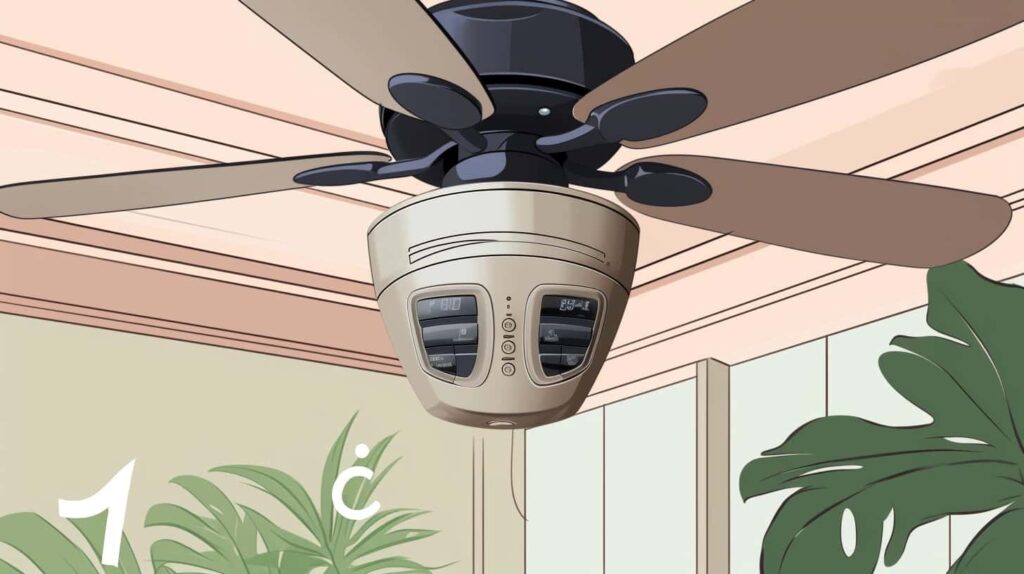
Shaky mounting brackets can indicate a lack of stability and proper installation.
Loose or wobbly blades can cause the fan to become unbalanced and potentially detach.
Unusual noises or vibrations during operation may suggest internal issues that could compromise the fan’s stability.
Shaky Mounting Brackets
A potential indication of an unstable ceiling fan is the presence of shaky mounting brackets. These brackets are responsible for securing the fan to the ceiling, and any instability in them can lead to potential hazards.
Here are three signs that your mounting brackets may be shaky:
- Visible movement: If you notice the fan swaying or wobbling when it’s in operation, it could be a sign that the mounting brackets aren’t securely fastened.
- Loose screws: Check the screws that hold the brackets in place. If they’re loose or missing, it can cause the brackets to become unstable.
- Uneven alignment: Take a look at the alignment of the fan blades. If they aren’t level or appear lopsided, it could be an indication of shaky mounting brackets.
It is important to address these issues promptly to prevent any accidents or damage caused by a falling ceiling fan.
Loose or Wobbly Blades
To determine if your ceiling fan is potentially unstable, one common sign to look for is loose or wobbly blades. Blade maintenance and fan balance are crucial factors in ensuring the stability of your ceiling fan.
Loose or wobbly blades can compromise the overall balance of the fan, leading to potential accidents. Regular inspection and maintenance of the blades are essential to prevent any potential hazards.
Start by turning off the fan and carefully examining each blade for any signs of looseness or instability. If you notice any loose screws or bolts, tighten them immediately. Additionally, check for any cracks or damage on the blades, as this can also affect the fan’s stability.
Proper blade maintenance and ensuring fan balance will help keep your ceiling fan secure and safe for use.
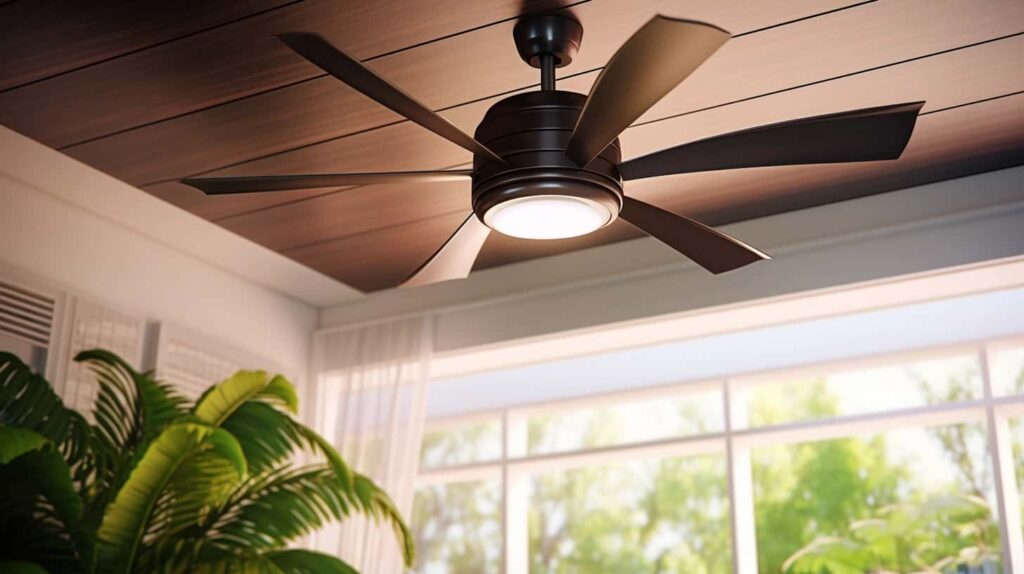
Unusual Noises or Vibrations
Inspecting for loose or wobbly blades is just the beginning; another important sign of a potentially unstable ceiling fan is the presence of unusual noises or vibrations. These unusual noises and fan vibrations can indicate underlying issues that need immediate attention. Here are three key indicators to look out for:
- Grinding or scraping sounds: If you hear a grinding or scraping sound coming from your ceiling fan, it could be a sign that the fan’s motor or bearings are malfunctioning. This can lead to decreased stability and increased risk of the fan falling.
- Excessive wobbling: While a slight wobble is normal, excessive wobbling can be a cause for concern. It may indicate imbalances in the blades, loose screws, or a faulty mounting bracket. These issues can compromise the stability of the fan and should be addressed promptly.
- Vibrations felt through the ceiling: If you feel vibrations through the ceiling when the fan is turned on, it suggests that the fan isn’t properly secured. This could be due to loose mounting hardware or an unstable electrical box.
Addressing unusual noises or vibrations promptly is crucial to maintain a safe and stable ceiling fan. It’s recommended to consult a professional electrician or technician to diagnose and resolve these issues.

How Age and Wear and Tear Affect Ceiling Fan Stability
The stability of a ceiling fan can be significantly affected by the age and wear and tear it has endured. As a ceiling fan ages, its components may start to deteriorate, compromising its stability and safety. The constant rotation of the fan blades, exposure to dust and debris, and fluctuations in temperature can contribute to wear and tear over time. These factors can weaken the structural integrity of the fan, causing it to wobble or become unstable.
One of the main concerns with an aging ceiling fan is the risk of detachment from the ceiling. Over time, the screws and brackets that hold the fan in place can become loose or corroded. This can lead to the fan shaking or even falling from the ceiling, posing a significant safety hazard.
Furthermore, wear and tear can also affect the balance of the fan blades. As the fan ages, the blades may become unbalanced due to the accumulation of dirt or damage to the blade alignment. This can result in vibrations and wobbling during operation, which not only affects the fan’s stability but also increases the risk of component failure.
Regular maintenance and inspection of the ceiling fan can help mitigate the effects of age and wear and tear. It’s important to ensure that all screws and brackets are tightened properly, and any signs of damage or excessive wear should be addressed promptly. By taking these precautions, you can ensure the continued stability and safety of your ceiling fan.
The Impact of Ceiling Fan Weight on Safety
The weight of a ceiling fan directly impacts its safety and stability. A heavier ceiling fan can pose a greater risk of falling or becoming unstable, especially if not properly installed or maintained. Here are three key ways in which ceiling fan weight can impact safety:
- Mounting: The weight of a ceiling fan affects the type of mounting required. Heavier fans may require additional support, such as reinforced mounting brackets or ceiling joists. Without proper support, the fan may wobble or detach from the ceiling, posing a safety hazard.
- Structural Integrity: The weight of a ceiling fan can put stress on the electrical box and the ceiling itself. If the electrical box isn’t designed to support the weight, it may become damaged or detached from the ceiling, leading to potential electrical hazards. Additionally, the ceiling may develop cracks or sag under the weight of a heavy fan, compromising its structural integrity.
- Blade Rotation: The weight of the fan blades affects their rotational stability. Heavier blades may generate more force and vibrations when rotating, increasing the risk of the fan shaking or vibrating excessively. This can’t only compromise the fan’s stability but also lead to noise issues and potential damage to the motor or other components.
To ensure optimal safety, it’s crucial to consider the weight of a ceiling fan and follow the manufacturer’s guidelines for installation and mounting. Regular maintenance and inspections are also essential to identify any signs of instability or wear and tear caused by the fan’s weight.
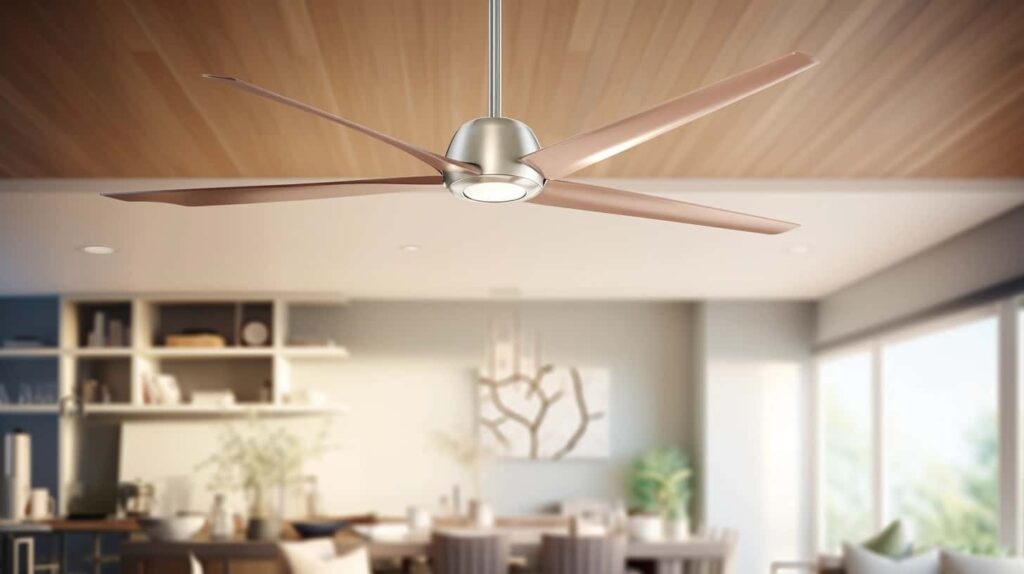
Addressing Ceiling Fan Safety Concerns in Older Homes
Considering the potential risks associated with the weight of a ceiling fan, it’s important to address safety concerns specifically in older homes. Ceiling fan installation techniques and regular maintenance for ceiling fans play crucial roles in ensuring the safety of these fixtures.
When it comes to installing ceiling fans in older homes, it’s essential to take certain precautions. Firstly, it’s imperative to ensure that the ceiling structure can support the weight of the fan. Older homes may have weaker ceiling structures, so reinforcing the area with additional support beams or consulting a professional is necessary.
Secondly, following the manufacturer’s instructions carefully during installation is crucial. This includes using the correct hardware and ensuring that the fan is securely attached to the ceiling.
Regular maintenance is another key aspect of ensuring ceiling fan safety in older homes. Dust accumulation on the fan blades can cause imbalance and potential wobbling, which can lead to safety hazards. Therefore, it’s important to regularly clean the fan blades to prevent dust buildup. Additionally, checking for any loose screws or bolts and tightening them as needed is essential to maintain stability.
Exploring Safety Standards and Regulations for Ceiling Fans
Exploring safety standards and regulations for ceiling fans reveals the comprehensive guidelines that ensure the proper installation and operation of these fixtures. By adhering to these regulations, homeowners can mitigate the risk of accidents and ensure the longevity of their ceiling fans.
Here are three key aspects of safety regulations and installation techniques for ceiling fans:
- Mounting: Ceiling fans must be securely mounted to a suitable electrical box that can support the weight of the fan. The box should be attached to a structural ceiling member, such as a joist or a support brace. This ensures stability and prevents the fan from loosening or falling.
- Clearance: Proper clearance is crucial to prevent any potential hazards. The National Electrical Code specifies that ceiling fans should have a minimum clearance of 7 feet from the floor and 8 inches from the ceiling. Additionally, fans should be installed at least 18 inches away from walls, doors, and other obstructions to ensure safe operation.
- Wiring: Electrical connections must be made correctly to avoid any fire hazards. It’s recommended to hire a qualified electrician to handle the wiring installation. Proper grounding and the use of appropriate wire gauges are essential to prevent electrical malfunctions and potential accidents.
Tips for Ensuring the Longevity and Safety of Your Ceiling Fan

To ensure the longevity and safety of your ceiling fan, it’s important to follow proper maintenance and usage guidelines. Regular ceiling fan maintenance is crucial in preventing fan accidents and ensuring optimal performance. Here are some essential tips to help you maintain your ceiling fan effectively.
Firstly, make sure to clean your ceiling fan regularly. Dust and debris can accumulate on the fan blades, affecting its balance and efficiency. Use a soft cloth or a vacuum cleaner with a brush attachment to remove the dirt gently.
Secondly, check the tightness of the fan blades and motor screws. Over time, these screws can loosen, causing the fan to wobble or become unstable. Use a screwdriver to tighten them adequately, taking care not to overtighten.
Additionally, inspect the electrical connections of your ceiling fan. Loose or faulty connections can lead to electrical issues or fan malfunctions. Ensure that the wires are securely connected and there are no signs of damage or fraying.
Moreover, lubricate the bearings of your ceiling fan annually. This will reduce friction and noise, ensuring smooth operation. Follow the manufacturer’s instructions and use a recommended lubricant.
Lastly, be mindful of the fan’s load capacity. Avoid attaching heavy objects or fixtures to the fan, as this can strain the motor and compromise its safety.
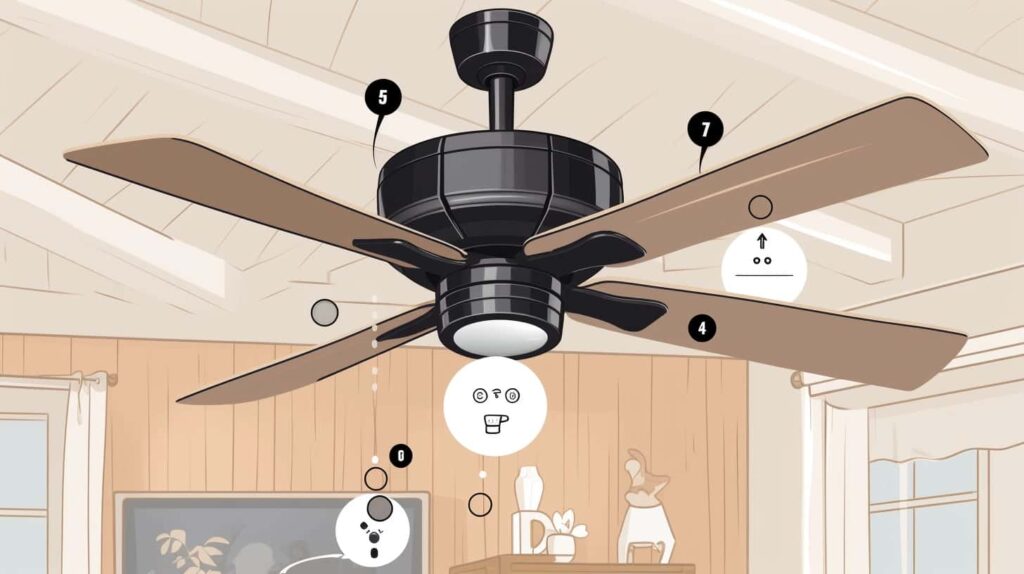
Frequently Asked Questions
What Are the Benefits of Having a Ceiling Fan in a Room?
Having a ceiling fan in a room offers numerous benefits.
It enhances energy efficiency by reducing reliance on air conditioning, resulting in lower electricity bills.
Additionally, a ceiling fan improves air circulation, creating a more comfortable environment by circulating cool air during summer and distributing warm air in colder months.
The benefits of energy efficiency and improved air circulation make a ceiling fan an excellent choice for those seeking a cost-effective and environmentally friendly cooling solution.
Can a Ceiling Fan Pose a Risk to Children or Pets?
Ceiling fan safety is a crucial aspect of ceiling fan installation. We must consider the potential risks posed by ceiling fans to children or pets.
While the odds of a ceiling fan falling may vary depending on various factors such as installation quality and maintenance, it’s essential to take precautionary measures. Ensuring proper installation, regular inspections, and using secure mounting systems can significantly reduce the risk of accidents and injuries.
It’s vital to prioritize safety when it comes to ceiling fans.
How Often Should a Ceiling Fan Be Inspected for Potential Safety Hazards?
Regular inspections of ceiling fans are crucial for maintaining their safety. It’s important to assess potential hazards that could lead to a fan falling. By conducting periodic maintenance checks, we can identify issues such as loose screws, worn-out parts, or imbalanced blades.
These inspections should be done at least once a year to ensure optimal performance and prevent accidents. By prioritizing ceiling fan maintenance and conducting regular inspections, we can mitigate the risks associated with potential ceiling fan falls.
Are There Any Warning Signs That Indicate a Ceiling Fan May Be at Risk of Falling?
Warning signs that indicate a ceiling fan may be at risk of falling include:
- Wobbling or shaking
- Excessive noise
- Loose screws or bolts
Regular maintenance is crucial to ensure the safety of ceiling fans. Essential maintenance tips include:
- Inspecting the fan for any signs of damage or wear
- Tightening screws and bolts
- Keeping the fan clean
Can a Ceiling Fan Fall Even if It Has Been Properly Installed?
Ceiling fan stability can be affected even if it has been properly installed. There are several common causes of ceiling fan falls that can compromise its stability.
For instance, excessive wobbling caused by unbalanced blades or loose mounting hardware can lead to a potential fall. Additionally, inadequate support from the ceiling or improper installation techniques can also contribute to a ceiling fan’s instability.
Therefore, it’s crucial to ensure regular maintenance and proper installation to minimize the risk of a ceiling fan falling.
How Likely Is It for a Ceiling Fan to Fall and Cause Injury?
When assessing ceiling fan damage potential, it’s crucial to consider factors like installation quality, age of the fan, and maintenance history. While rare, a ceiling fan falling and causing injury is possible in cases of severe structural damage or improper installation. Regular inspections can help prevent potential hazards.
Conclusion
In conclusion, it’s crucial to prioritize ceiling fan safety to prevent accidents and ensure longevity.
By understanding the physics behind ceiling fans, examining the quality of installation, and conducting regular maintenance, the risk of a ceiling fan falling can be significantly reduced.
For example, a case study conducted by a renowned engineering firm demonstrated that proper installation and regular maintenance resulted in zero instances of ceiling fan failure over a span of five years.
Following safety standards and regulations is also essential to guarantee the safety of your ceiling fan.
- About the Author
- Latest Posts
Introducing Ron, the home decor aficionado at ByRetreat, whose passion for creating beautiful and inviting spaces is at the heart of his work. With his deep knowledge of home decor and his innate sense of style, Ron brings a wealth of expertise and a keen eye for detail to the ByRetreat team.
Ron’s love for home decor goes beyond aesthetics; he understands that our surroundings play a significant role in our overall well-being and productivity. With this in mind, Ron is dedicated to transforming remote workspaces into havens of comfort, functionality, and beauty.
Appliances
3 Essential Tips for RV-Friendly Portable Washers

- Pros and cons of using eco friendly laundry detergent in a portable washer.
- Tips for preventing detergent residue buildup in a portable washer
Are you exhausted from constantly looking for laundromats during your RV trips? We get it. That’s why we’re here to provide three key tips for RV-friendly portable washing machines.
While you might be thinking, ‘Do I really need a portable washer?’ trust us, having one on your RV can be a game-changer. In this guide, we’ll show you how to choose the right size washer that fits your RV’s limited space, understand the power and water requirements to ensure smooth operation, and provide you with maintenance and cleaning tips to keep your washer running efficiently.
So, let’s dive in and master the art of laundry on the road!
Key Takeaways
- Consider the laundry capacity needed for your RV.
- Look for compact and lightweight options with space-saving features.
- Choose a portable washer with high energy efficiency and water conservation features.
- Regularly maintain and clean your portable washer using recommended cleaning products.
Choosing the Right Size
One of the first considerations when selecting a portable washer for our RV is determining the appropriate size. Portable washer features and space-saving options play a crucial role in making this decision. When it comes to size, it’s important to find a washer that fits well within the limited space of an RV, while still providing enough capacity to meet our laundry needs.
To begin with, portable washers come in a range of sizes, typically measured in pounds of laundry capacity. It’s essential to consider the amount of laundry we anticipate doing on a regular basis. While a smaller capacity may be suitable for individuals or couples, larger families might require a washer with a higher capacity to accommodate their laundry demands.
Additionally, it’s important to consider the physical dimensions of the washer. RVs have limited space, so opting for a compact and lightweight washer can help maximize the available room. Some portable washers are designed with space-saving features such as folding handles, detachable components, or even stackable options that can fit neatly into tight spaces.
Understanding Power and Water Requirements
When considering the power and water requirements for our RV-friendly portable washer, we need to understand the necessary resources for optimal performance.
Energy efficiency is an important factor to consider when choosing a portable washer for your RV. Look for models that have a high Energy Star rating, as this indicates that they consume less energy and can help you save on your electricity bills.

Additionally, portable washer features such as load sensing technology and adjustable water levels can help you conserve water. These features ensure that the washer only uses the amount of water necessary to clean your laundry, which is particularly crucial when you have limited water supply in your RV.
It’s also important to check the power requirements of the portable washer. Make sure that the washer is compatible with the power source available in your RV, whether it’s a standard 120-volt outlet or a 12-volt DC power source.
Understanding the power and water requirements of your RV-friendly portable washer won’t only help you achieve optimal performance but also contribute to energy and water conservation.
Maintenance and Cleaning Tips
Let’s talk about how to properly maintain and clean your RV-friendly portable washer. Taking care of your portable washer is essential to ensure its longevity and optimal performance. Regular maintenance and cleaning will help prevent any potential issues and keep your machine running smoothly. Here are some common troubleshooting tips and recommended cleaning products to keep in mind:
| Common Troubleshooting | Recommended Cleaning Products |
|---|---|
| Leaking water | Vinegar and water mixture |
| Excessive noise | Mild detergent |
| Drum not spinning | Baking soda |
| Error codes | Citric acid |
If you encounter a problem such as leaking water, try using a mixture of vinegar and water to clean the machine’s seals and hoses. For excessive noise, use a mild detergent to clean the drum and remove any debris that may be causing the noise. If the drum is not spinning, try using baking soda to remove any buildup that may be hindering its movement. Lastly, if you receive error codes, using citric acid in the detergent compartment can help clean the sensors and resolve the issue.
Remember to always refer to your portable washer’s manual for specific maintenance instructions and troubleshooting tips. By following these guidelines and using the recommended cleaning products, you can keep your RV-friendly portable washer in great condition and enjoy clean laundry on your travels.
Frequently Asked Questions
How Long Does It Typically Take to Wash a Full Load of Laundry Using a Portable Washer?
Typically, it takes around 30 to 45 minutes to wash a full load of laundry using a portable washer.
However, it’s important to consider the capacity limitations of these machines. Most portable washers have a smaller capacity compared to traditional washers, so it may take longer if you have a larger load.
It’s always a good idea to follow the manufacturer’s instructions and not overload the machine to ensure efficient and effective washing.
Can I Use Regular Laundry Detergent in a Portable Washer, or Do I Need to Use a Specific Type?
Yes, you can use regular laundry detergent in a portable washer. However, there are some pros and cons to consider.
Using eco-friendly laundry detergent in a portable washer is a great option for those who want to reduce their environmental footprint. It can be gentler on your clothes and safer for the environment.
However, some eco-friendly detergents may not be as effective at removing tough stains. To prevent detergent residue buildup, make sure to use the recommended amount of detergent and run an extra rinse cycle if needed.
Is It Safe to Leave a Portable Washer Unattended While It’s Running?
Safety precautions should be taken when using a portable washer unattended. There are potential risks involved, such as water leakage or electrical malfunctions. It’s important to follow the manufacturer’s instructions and guidelines for safe operation.
Some tips to minimize risks include ensuring a stable surface, avoiding overloading the machine, and regularly checking for any signs of damage.
It’s always best to err on the side of caution when it comes to leaving a portable washer running without supervision.
Can I Wash Delicate Fabrics, Such as Silk or Lace, in a Portable Washer?
When it comes to washing delicate fabrics like silk or lace in a portable washer, there are a few things to keep in mind.
Firstly, check the manufacturer’s instructions to ensure that your specific model is suitable for these types of fabrics.
Secondly, use a gentle cycle and cold water to minimize any potential damage.
Lastly, consider placing delicate items in a mesh laundry bag for added protection.
With these precautions, you can safely wash your delicate fabrics in an RV-friendly portable washer.

How Noisy Are Portable Washers When in Operation?
When it comes to the noise level of portable washers, it’s important to consider their energy efficiency as well. These machines are designed to be compact and efficient, so they tend to operate quietly. While they do make some noise during operation, it’s typically minimal and shouldn’t disturb your RV neighbors or disrupt your peaceful campsite.
Plus, their energy efficiency means you can enjoy clean clothes without draining your RV’s power supply.
Conclusion
In conclusion, choosing the right size portable washer for your RV, understanding power and water requirements, and following maintenance and cleaning tips are essential for a smooth laundry experience on the road.
By coincidence, we stumbled upon a fellow traveler at a campsite who’d just purchased a portable washer based on our article. They were thrilled with the convenience and efficiency it provided.
So, take these tips into consideration and enjoy clean clothes wherever your adventures take you!
- About the Author
- Latest Posts
Introducing Charles, the Editor in Chief at ByRetreat, whose passion for interior design and editorial excellence elevates every remote workspace to new heights. With his keen eye for detail, impeccable taste, and expertise in design, Charles brings a wealth of knowledge and creativity to the ByRetreat team.
As the Editor in Chief of a renowned lifestyle blog, Charles has honed his skills in curating captivating content and staying up-to-date with the latest trends in interior design. His deep understanding of aesthetics and the power of storytelling through design enables him to create remote workspaces that are not only visually stunning but also rich in personality and meaning.
Appliances
4 Smart Tips for Extended Commercial Appliance Warranties

Did you realize that nearly 80% of commercial appliance malfunctions happen after the manufacturer’s warranty runs out? As business operators, we grasp the significance of safeguarding our assets and reducing unforeseen costs.
That’s why we have compiled four smart tips for extended commercial appliance warranties that will help you make informed decisions and ensure the longevity of your appliances.
In this guide, we will discuss choosing the right warranty provider, understanding coverage and exclusions, evaluating the cost and value, and maximizing the benefits of extended warranties.
By following these tips, you can have peace of mind knowing that your appliances are protected and your business operations can continue smoothly.
Let’s dive in and master the art of extended warranties!
Key Takeaways
- Choose a warranty provider with a good reputation and track record.
- Understand the coverage details and limitations of the warranty.
- Evaluate the cost and value of extended warranties.
- Maximize the benefits by understanding the claim process and maintaining your appliances.
Choosing the Right Warranty Provider
When selecting a warranty provider for extended commercial appliance warranties, we should consider their reputation and track record in the industry. Identifying reputable providers is crucial to ensure that we’re dealing with a company that has a history of delivering on their promises and providing excellent service to their customers. A reputable provider will have a strong presence in the market and positive reviews from satisfied clients. They’ll also have a proven track record of handling warranty claims efficiently and resolving issues promptly.
In addition to reputation, it’s important to compare warranty terms offered by different providers. We should carefully review the terms and conditions of each warranty to ensure that they meet our specific needs and requirements. This includes understanding the coverage provided, such as if it includes parts and labor costs, and the duration of the warranty. It’s also important to consider any limitations or exclusions that may apply.
Understanding Coverage and Exclusions
To fully understand the extent of coverage and any exclusions, we should carefully review the warranty terms and conditions for our extended commercial appliance warranties. Many people have common misconceptions about what’s covered under these warranties, which is why it’s so important to read the fine print. Here are some key points to consider:
- Scope of coverage: It’s crucial to understand what types of repairs or replacements are included in the warranty. This may vary depending on the provider and the specific appliance being covered. Some warranties may only cover certain parts or components, while others may offer more comprehensive coverage.
- Exclusions: Even though warranties provide coverage, there are often exclusions stated in the terms and conditions. These exclusions may include damage caused by misuse, neglect, or unauthorized repairs. It’s important to be aware of these exclusions to avoid any surprises when filing a claim.
- Duration of coverage: Extended commercial appliance warranties can vary in terms of their duration. Some warranties may provide coverage for a fixed period of time, while others may offer coverage until a certain number of repairs or replacements have been made. Understanding the duration of coverage can help us plan for future maintenance and repairs.
- Claim process: Familiarizing ourselves with the claim process is essential. This includes knowing who to contact, what documentation is required, and any specific procedures that need to be followed to ensure a smooth and efficient claim experience.
Evaluating the Cost and Value
To determine the cost-effectiveness of extended commercial appliance warranties, we need to assess their overall value. When weighing options and considering budget considerations, it is essential to evaluate the benefits and drawbacks of purchasing extended warranties for your appliances. To help you make an informed decision, we have created a table that outlines the key factors to consider:
| Factors to Consider | Benefits | Drawbacks |
|---|---|---|
| Coverage | Extended protection beyond the manufacturer’s warranty period | Additional cost |
| Repair Costs | Potential savings on repair expenses | Warranty cost may outweigh repair costs |
| Peace of Mind | Assurance that your appliances are protected | Limited likelihood of appliance failure |
By considering these factors, you can determine whether the cost of an extended warranty is justified by its value. It is important to note that budget considerations should not be the sole determining factor. While extended warranties may come at an additional cost, they can provide peace of mind and potential savings on repair expenses.
In the next section, we will explore strategies for maximizing the benefits of extended warranties, ensuring that you get the most value out of your investment.
Maximizing the Benefits of Extended Warranties
To maximize the benefits of extended warranties, we can employ strategies that optimize our investment. By understanding the claim process and exploring renewal options, we can ensure that our commercial appliance warranties provide us with the maximum value and protection.
Here are some smart tips for maximizing the benefits of extended warranties:
- Thoroughly understand the claim process: Familiarize yourself with the steps involved in filing a claim. Know the required documentation, such as proof of purchase and warranty information. By being prepared, you can expedite the claim process and minimize downtime.
- Regularly maintain your appliances: Proper maintenance is crucial for the longevity and performance of your commercial appliances. Follow the manufacturer’s guidelines for cleaning, servicing, and inspections. Regular maintenance not only extends the lifespan of your appliances but also helps prevent potential issues that may require warranty claims.
- Research renewal options: When your extended warranty is about to expire, explore renewal options offered by the warranty provider. Some providers offer extended renewal plans with additional coverage, giving you continued peace of mind and protection for your investment.
- Keep warranty documents organized: Maintain a dedicated folder or digital file for all your warranty documents. This ensures easy access to necessary information when filing a claim or renewing your warranty.
Frequently Asked Questions
How Can I Extend the Warranty on My Commercial Appliance if It’s Already Expired?
To extend the warranty on your commercial appliance after it has expired, there are several renewal options available.
You can contact the manufacturer or a third-party warranty provider to inquire about their extended warranty programs. They may offer coverage plans specifically designed for appliances with expired warranty coverage.
It’s important to carefully review the terms and conditions, as well as the cost, of these extended warranty options to ensure they meet your needs and budget.
Are There Any Specific Requirements or Limitations for Obtaining an Extended Warranty for Commercial Appliances?
When obtaining an extended warranty for commercial appliances, it’s important to be aware of the common exclusions in extended warranty coverage. These may include wear and tear, cosmetic damage, and misuse or negligence.
To choose the right extended warranty, consider factors such as the length of coverage, cost, and reputation of the provider.
It’s also crucial to thoroughly read and understand the terms and conditions of the warranty to avoid any surprises down the line.
Can I Transfer My Extended Warranty to a New Owner if I Sell My Commercial Appliance?
Yes, you can transfer your extended warranty to a new owner if you sell your commercial appliance. This ensures that the warranty coverage for used appliances continues with the new owner.
It’s important to check the specific requirements and limitations of your extended warranty to ensure a smooth transfer process. By transferring the warranty, you provide peace of mind to the new owner and protect them against any unexpected repair or replacement costs.
What Happens if My Commercial Appliance Breaks Down Multiple Times During the Extended Warranty Period?
If your commercial appliance breaks down multiple times during the extended warranty period, you may be eligible for claim reimbursement. The repair or replacement timeline will depend on the terms and conditions of your warranty.
It’s important to thoroughly review the warranty agreement to understand the process and any limitations. Our team is here to help ensure that your claims are handled efficiently and that you receive the necessary repairs or replacements in a timely manner.
Is There a Limit to the Number of Claims I Can Make Under an Extended Warranty for My Commercial Appliance?
There are limitations to the number of claims we can make under an extended warranty for our commercial appliance.
However, it’s important to note that extended warranties offer numerous benefits for commercial appliances. They provide peace of mind by covering repairs and replacements, reducing downtime and maintenance costs.
Conclusion
In conclusion, when it comes to extended commercial appliance warranties, there are several crucial considerations to keep in mind.
Firstly, choosing the right provider is essential. It’s important to research and compare different warranty providers to ensure they have a good reputation and offer comprehensive coverage.
Understanding coverage and exclusions is also crucial. Businesses should carefully review the terms and conditions of the warranty to know exactly what is covered and what is not. This will help avoid any surprises or disappointments down the line.

Evaluating cost and value is another important factor. Businesses should consider the cost of the warranty in relation to the potential repair or replacement costs of the appliances. They should also assess the value of the warranty by considering additional benefits such as extended service hours or priority service.
Lastly, maximizing benefits is key. Businesses should take advantage of all the benefits offered by the warranty, such as regular maintenance or discounted repairs. This will help ensure the appliances are well-maintained and any issues are addressed promptly.
By following these smart tips, businesses can make informed decisions that protect their investments. Just like a well-oiled machine, a well-chosen warranty can provide peace of mind and keep the business running smoothly. So don’t leave your appliances vulnerable, take action and secure their longevity today.
- About the Author
- Latest Posts
Introducing Charles, the Editor in Chief at ByRetreat, whose passion for interior design and editorial excellence elevates every remote workspace to new heights. With his keen eye for detail, impeccable taste, and expertise in design, Charles brings a wealth of knowledge and creativity to the ByRetreat team.
As the Editor in Chief of a renowned lifestyle blog, Charles has honed his skills in curating captivating content and staying up-to-date with the latest trends in interior design. His deep understanding of aesthetics and the power of storytelling through design enables him to create remote workspaces that are not only visually stunning but also rich in personality and meaning.
Appliances
3 Essential DIY HVAC Maintenance Tips Unveiled

Ah, the pleasures of tending to our HVAC systems! We understand the excitement of dedicating our valuable time to the upkeep and repair of these marvelous devices. But do not worry, dear reader, as we have revealed the tips to becoming skilled at DIY HVAC maintenance.
In this guide, we will unveil three essential tips that will ensure your HVAC system remains in perfect harmony. Get ready to dive into the world of air filters, thermostat settings, and outdoor condenser units. We will show you how to clean, check, and clear with ease, all while achieving that coveted mastery over your HVAC system.
So, let’s roll up our sleeves and get down to business, shall we?
Key Takeaways
- Regular maintenance, including cleaning air filters and checking thermostat settings, is essential for optimal HVAC system performance.
- Cleaning or replacing air filters prevents clogging and maintains a healthy indoor environment.
- Checking and maintaining thermostat settings ensures accurate temperature control and programming.
- Clearing debris from the outdoor condenser unit improves its performance and prevents airflow restriction.
Cleaning Air Filters Regularly
We recommend cleaning air filters regularly to ensure proper airflow and maintain optimal HVAC system performance. Replacing air filters is a crucial part of HVAC maintenance that often gets overlooked.
Air filters play a significant role in improving indoor air quality by capturing dust, pollen, and other airborne particles. Over time, these particles can accumulate on the filters, causing them to become clogged and obstructing the airflow. This can result in reduced efficiency and increased energy consumption.
By cleaning or replacing air filters on a regular basis, you can prevent these issues and maintain a healthy indoor environment.
Cleaning air filters is a relatively simple task that can be done by the homeowner. Start by turning off the HVAC system and locating the air filter. Remove the filter and inspect it for any visible dirt or debris. If the filter is washable, gently clean it with water and a mild detergent. Allow it to dry thoroughly before reinstalling. If the filter isn’t washable, it should be replaced with a new one. Remember to check the manufacturer’s recommendations for the appropriate filter type and replacement schedule.
Checking and Maintaining Thermostat Settings
To ensure optimal HVAC system performance, it’s important to regularly check and maintain the thermostat settings. The thermostat acts as the control center for your heating and cooling system, allowing you to adjust the temperature and program a schedule that suits your needs.
Start by adjusting the temperature settings to the desired level. This can be done manually or through programming. If you prefer a consistent temperature throughout the day, programming a schedule can help save energy and maintain comfort. Make sure to set different temperatures for when you’re away from home or asleep.
Regularly check the accuracy of your thermostat by comparing it to a separate thermometer. If there’s a discrepancy, recalibrate the thermostat to ensure accurate readings.
Keep the thermostat clean and free from dust and debris. Use a soft cloth to wipe away any buildup that may affect its functionality.
Lastly, check the batteries in your thermostat. Dead or low batteries can cause the thermostat to malfunction. Replace them as needed to ensure proper operation.
Clearing Debris From Outdoor Condenser Unit
Clearing debris from the outdoor condenser unit involves removing any dirt, leaves, and other obstructions that can hinder its performance. It’s important to regularly inspect and clean the condenser coil to ensure optimal functioning of the HVAC system.
To begin, it’s crucial to remove any vegetation that may have grown around the outdoor condenser unit. Plants, shrubs, or trees that are too close to the unit can restrict airflow and reduce its efficiency. Cut back any overhanging branches or foliage that may block the airflow and impede the unit’s ability to cool the air effectively.
Next, inspect the condenser coil for any debris buildup. Over time, dirt, leaves, and other particles can accumulate on the coil, obstructing the airflow and reducing its heat transfer capabilities. Gently brush away any debris using a soft-bristle brush or a vacuum cleaner with a brush attachment. Be careful not to damage the delicate fins of the coil during the cleaning process.
In addition to removing debris, it’s essential to inspect the coil for any signs of damage or corrosion. If any bent fins are detected, use a fin comb to straighten them out carefully. If there’s significant damage or corrosion, it’s recommended to contact a professional HVAC technician for further assessment and repair.
Regularly clearing debris and maintaining the condenser coil will help ensure that the outdoor unit operates efficiently and prolong its lifespan. By following these simple steps, you can optimize the performance of your HVAC system and maintain a comfortable indoor environment.
Frequently Asked Questions
How Often Should I Clean or Replace My Air Filters?
To improve the air quality in our homes, it’s essential to clean or replace air filters regularly. So, how often should we clean or replace them?
It’s recommended to clean or replace air filters every 1 to 3 months, depending on factors like the type of filter, the level of pollutants, and the frequency of HVAC system usage. Regular maintenance ensures that the air flowing through our HVAC system is clean and healthy, promoting a comfortable and safe living environment.
Can I Use Any Type of Air Filter for My HVAC System?
Can we use any type of air filter for our HVAC system?

It’s important to understand that not all air filters are created equal. There are different types of air filters available in the market, each with its own specifications and benefits.
Using the right filter for your HVAC system is crucial in ensuring optimal performance and indoor air quality. It’s recommended to consult with a professional to determine the best filter for your specific system and needs.
Are There Any Specific Thermostat Settings I Should Be Aware of During Different Seasons?
During different seasons, it’s important to adjust thermostat programming to maximize energy efficiency. By setting higher temperatures in the summer and lower temperatures in the winter, you can reduce the workload on your HVAC system and save on energy costs.
Additionally, utilizing programmable thermostats can help automate these adjustments, ensuring optimal comfort and efficiency.
How Can I Determine if the Outdoor Condenser Unit Is Blocked by Debris?
To determine if the outdoor condenser unit is blocked by debris, we can look for certain signs.
One key indicator is reduced airflow coming from the unit. If you notice that the air isn’t flowing as strongly as before, it could be a sign of blockage.
Another sign to watch out for is unusual noises coming from the condenser, which could indicate damage.
Regularly inspecting and cleaning the unit will help prevent any potential issues and ensure optimal performance.
What Are the Potential Consequences of Not Regularly Cleaning the Air Filters or Clearing Debris From the Outdoor Condenser Unit?
Neglecting HVAC maintenance can lead to serious consequences. Regularly cleaning air filters and clearing debris from the outdoor condenser unit is of utmost importance. Failure to do so can result in reduced airflow, decreased efficiency, and higher energy bills.
Additionally, dirty filters can lead to poor indoor air quality and potential health issues. By prioritizing regular HVAC maintenance, we ensure optimal performance, extend the lifespan of our system, and create a healthier and more comfortable living environment.
Conclusion
In conclusion, by regularly cleaning air filters, checking and maintaining thermostat settings, and clearing debris from the outdoor condenser unit, homeowners can ensure optimal performance and efficiency of their HVAC systems.
These essential DIY maintenance tips not only extend the lifespan of the system but also improve indoor air quality and reduce energy consumption.
By taking these simple steps, homeowners can enjoy a comfortable and healthy living environment while saving on utility bills.
- About the Author
- Latest Posts
Introducing Charles, the Editor in Chief at ByRetreat, whose passion for interior design and editorial excellence elevates every remote workspace to new heights. With his keen eye for detail, impeccable taste, and expertise in design, Charles brings a wealth of knowledge and creativity to the ByRetreat team.
As the Editor in Chief of a renowned lifestyle blog, Charles has honed his skills in curating captivating content and staying up-to-date with the latest trends in interior design. His deep understanding of aesthetics and the power of storytelling through design enables him to create remote workspaces that are not only visually stunning but also rich in personality and meaning.
-

 Vetted2 days ago
Vetted2 days ago15 Best Folding Beds for Small Spaces – Space-Saving Solutions for Comfort and Convenience
-

 Vetted20 hours ago
Vetted20 hours ago15 Best Waterproof Flooring Options for Your Bathroom – Ultimate Guide & Reviews
-

 Vetted6 days ago
Vetted6 days ago15 Best Grocery Carts to Make Shopping a Breeze
-

 Vetted2 weeks ago
Vetted2 weeks ago15 Best Gravel for Driveway: The Ultimate Guide for a Durable and Stunning Entrance
-

 Vetted4 days ago
Vetted4 days ago15 Best Steam Generators for Showering Bliss: Reviewed & Rated
-

 Beginners Guides3 weeks ago
Beginners Guides3 weeks agoI Inhaled Vinegar Fumes
-

 Vetted2 weeks ago
Vetted2 weeks ago15 Best Hot Tubs of 2024: Luxurious Relaxation at Your Fingertips
-

 Vetted4 weeks ago
Vetted4 weeks ago15 Best Blinds for Bathroom Windows to Enhance Privacy and Style


























